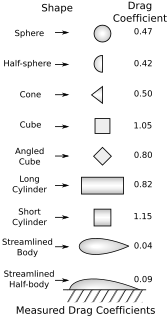
A hybrid vehicle uses two or more distinct types of power, such as internal combustion engine to drive an electric generator that powers an electric motor, e.g. in diesel-electric trains using diesel engines to drive an electric generator that powers an electric motor, and submarines that use diesels when surfaced and batteries when submerged. Other means to store energy include pressurized fluid in hydraulic hybrids.
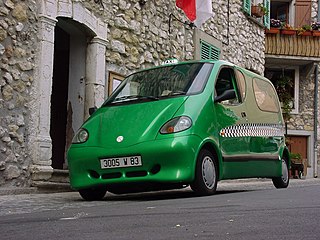
A compressed air car is a compressed air vehicle that uses a motor powered by compressed air. The car can be powered solely by air, or combined with gasoline, diesel, ethanol, or an electric plant with regenerative braking.
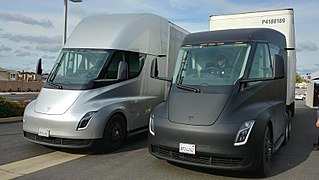
An electric vehicle, also called an EV, uses one or more electric motors or traction motors for propulsion. An electric vehicle may be powered through a collector system by electricity from off-vehicle sources, or may be self-contained with a battery, solar panels or an electric generator to convert fuel to electricity. EVs include, but are not limited to, road and rail vehicles, surface and underwater vessels, electric aircraft and electric spacecraft.

The Mitsubishi Outlander is a compact crossover SUV manufactured by Japanese automaker Mitsubishi Motors. It was originally known as the Mitsubishi Airtrek when it was introduced in Japan in 2001, and was based on the Mitsubishi ASX concept vehicle exhibited at the 2001 North American International Auto Show. It was sold at Mitsubishi Japan dealership chain called Car Plaza. The ASX represented Mitsubishi's approach to the industry wide crossover SUV trend for retaining the all-season and off-road abilities offered by a high ground clearance and four-wheel drive, while still offering car-like levels of emissions, economy, and size.
Hybrid Synergy Drive (HSD) is the brand name of Toyota Motor Corporation for the hybrid car drive train technology used in vehicles with the Toyota and Lexus marques. First introduced on the Prius, the technology is an option on several other Toyota and Lexus vehicles and has been adapted for the electric drive system of the hydrogen-powered Mirai, and for a plug-in hybrid version of the Prius. Previously, Toyota also licensed its HSD technology to Nissan for use in its Nissan Altima Hybrid. Its parts supplier Aisin Seiki Co. offers similar hybrid transmissions to other car companies.

A solar vehicle is an electric vehicle powered completely or significantly by direct solar energy. Usually, photovoltaic (PV) cells contained in solar panels convert the sun's energy directly into electric energy. The term "solar vehicle" usually implies that solar energy is used to power all or part of a vehicle's propulsion. Solar power may be also used to provide power for communications or controls or other auxiliary functions.

A plug-in hybrid electric vehicle (PHEV) is a hybrid electric vehicle whose battery can be recharged by plugging it into an external source of electric power, as well by its on-board engine and generator. Most PHEVs are passenger cars, but there are also PHEV versions of commercial vehicles and vans, utility trucks, buses, trains, motorcycles, scooters, and military vehicles.
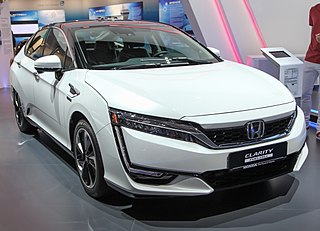
The Honda Clarity is a nameplate used by Honda on alternative fuel vehicles. It was initially used only on hydrogen fuel-cell electric vehicles such as the 2008 Honda FCX Clarity, but in 2017 the nameplate was expanded to include the battery-electric Honda Clarity Electric and the plug-in hybrid electric Honda Clarity Plug-in Hybrid, in addition to the next generation Honda Clarity Fuel Cell.

The Ford Reflex is a concept car introduced at the 2006 North American International Auto Show that, according to Ford, "proves small cars can be bold and American". It is a technological showcase that includes solar panel-powered headlights, integrated child seat, baby cam with a monitor mounted on the dash, inflatable rear safety belts, and an interior quieted by ground rubber taken from Nike athletic shoe outsoles. A production version of the Reflex design has not yet been announced. It features an advanced diesel-electric hybrid engine with new-generation lithium ion batteries that help deliver up to 65 miles per US gallon of diesel fuel, and can accelerate the vehicle from 0 to 60 mph (97 km/h) in 7 seconds.
The Dodge Intrepid ESX prototype cars are the result of the 1993 response by the Chrysler Corporation to a challenge by U.S. President Bill Clinton to produce a vehicle which was capable of meeting the demands of the modern consumer, while still achieving an unprecedented 80 miles per US gallon overall in fuel economy. The PNGV - Partnership for a New Generation of Vehicles project was aimed at The Big Three American car manufacturers.
Hybrid vehicle drivetrains transmit power to the driving wheels for hybrid vehicles. A hybrid vehicle has multiple forms of motive power.
MIEV or MiEV is the name given by Japanese automaker Mitsubishi Motors (MMC) to its alternative propulsion technologies. From late 2006, “MiEV” encompasses all of Mitsubishi Motors’s electric drive systems work, including lithium-ion batteries, in-wheel motors and other technologies related to electric vehicle(EV), hybrid-electric vehicle and fuel-cell vehicles.

The Chevrolet Volt is a plug-in hybrid car manufactured by General Motors, also marketed in rebadged variants as the Holden Volt in Australia and New Zealand, Buick Velite 5 in China, and with a different fascia as the Vauxhall Ampera in the United Kingdom and as the Opel Ampera in the remainder of Europe. Volt production ended in February 2019.
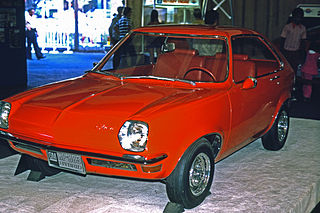
In the late 1960s, General Motors Company directed its GM R&D and Pontiac divisions to develop concept mini-cars for urban drivers. Pontiac developed the Pontiac X-4 with a radical two stroke aircraft type radial engine, and GM developed the XP-883 an experimental plug-in hybrid car demonstrated by General Motors in 1969. Primarily intended as a commuter vehicle, the very small car had a fiberglass body with a design resembling the future Chevrolet Vega or Ford Pinto. The two-door hatchback had seating for two adults and two children, though the children sat in rear-facing seats and would enter and exit through the tailgate. It was powered by the combination of a two-cylinder engine and a DC electric motor. Electricity was stored in six 12-volt batteries placed between the rear wheels.

Audi hybrid vehicles are hybrid electric vehicles created by the German carmaker, Audi. Some vehicles listed were concept vehicles, which utilised an internal combustion engine and an electric motor, and were used for research and development (R&D) for potential future use of the technology into possible series production. Audi launched its first hybrid concept car in 1989 called the Audi Duo, and was the first European company to sell a hybrid in 1997, though only in very small numbers.

A battery electric vehicle (BEV), pure electric vehicle, only-electric vehicle or all-electric vehicle is a type of electric vehicle (EV) that uses chemical energy stored in rechargeable battery packs. BEVs use electric motors and motor controllers instead of internal combustion engines (ICEs) for propulsion. They derive all power from battery packs and thus have no internal combustion engine, fuel cell, or fuel tank. BEVs include - but are not limited to - motorcycles, bicycles, scooters, skateboards, rail cars, watercraft, forklifts, buses, trucks, and cars.

The Electrosport was a compact-sized electric vehicle using AMC Hornets that were converted by the Electric Fuel Propulsion Company (EFP) of Ferndale, Michigan.

The Mitsubishi i-MiEV is a five-door hatchback electric car produced by Mitsubishi Motors, and is the electric version of the Mitsubishi i. Rebadged variants of the i-MiEV are also sold in Europe by PSA Peugeot Citroën (PSA) as the Peugeot iOn and Citroën C-Zero. The i-MiEV is the world's first modern highway-capable mass production electric car.
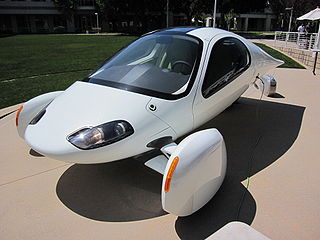
The Aptera 2 Series was a high-efficiency passenger three-wheeled automobile under development by Aptera Motors. The California-based company opened a pre-ordering process for residents of California, but stopped taking deposits in July 2011, and on August 12, 2011, Aptera announced it would return all deposits from customers who had signed up to buy an Aptera 2e electric car or the planned 2h hybrid, before the company finally folded in December 2011.

Not to be confused with the 2012 production car, Kia Ray.





